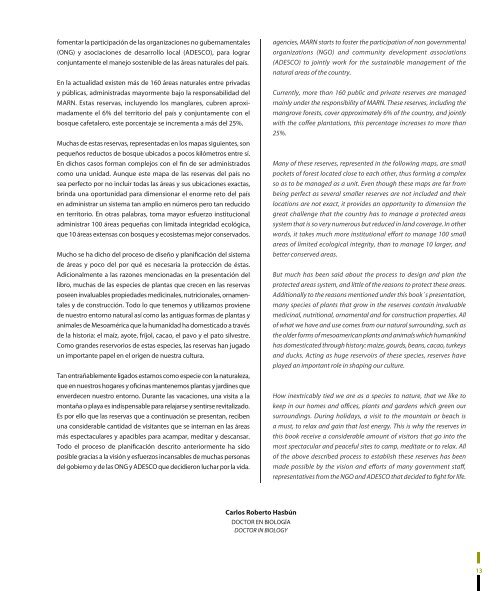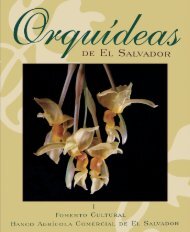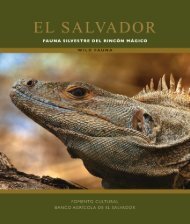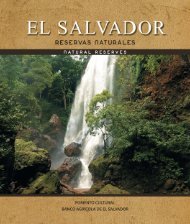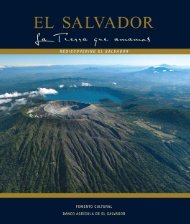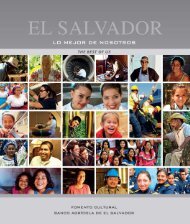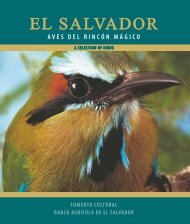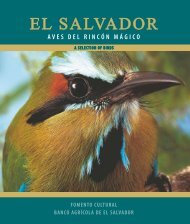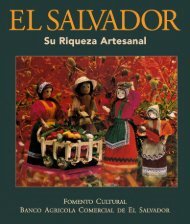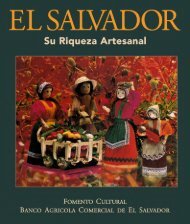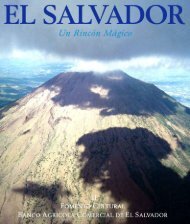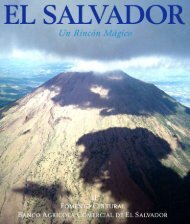You also want an ePaper? Increase the reach of your titles
YUMPU automatically turns print PDFs into web optimized ePapers that Google loves.
fomentar la participación de las organizaciones no gubernamentales<br />
(ONG) y asociaciones de desarrollo local (ADESCO), para lograr<br />
conjuntamente el manejo sostenible de las áreas naturales del país.<br />
En la actualidad existen más de 160 áreas naturales entre privadas<br />
y públicas, administradas mayormente bajo la responsabilidad del<br />
MARN. Estas reservas, incluyendo los manglares, cubren aproximadamente<br />
el 6% del territorio del país y conjuntamente con el<br />
bosque cafetalero, este porcentaje se incrementa a más del 25%.<br />
Muchas de estas reservas, representadas en los mapas siguientes, son<br />
pequeños reductos de bosque ubicados a pocos kilómetros entre sí.<br />
En dichos casos forman complejos con el fin de ser administrados<br />
como una unidad. Aunque este mapa de las reservas del país no<br />
sea perfecto por no incluir todas las áreas y sus ubicaciones exactas,<br />
brinda una oportunidad para dimensionar el enorme reto del país<br />
en administrar un sistema tan amplio en números pero tan reducido<br />
en territorio. En otras palabras, toma mayor esfuerzo institucional<br />
administrar 100 áreas pequeñas con limitada integridad ecológica,<br />
que 10 áreas extensas con bosques y ecosistemas mejor conservados.<br />
Mucho se ha dicho del proceso de diseño y planificación del sistema<br />
de áreas y poco del por qué es necesaria la protección de éstas.<br />
Adicionalmente a las razones mencionadas en la presentación del<br />
libro, muchas de las especies de plantas que crecen en las reservas<br />
poseen invaluables propiedades medicinales, nutricionales, ornamentales<br />
y de construcción. Todo lo que tenemos y utilizamos proviene<br />
de nuestro entorno natural así como las antiguas formas de plantas y<br />
animales de Mesoamérica que la humanidad ha domesticado a través<br />
de la historia: el maíz, ayote, fríjol, cacao, el pavo y el pato silvestre.<br />
Como grandes reservorios de estas especies, las reservas han jugado<br />
un importante papel en el origen de nuestra cultura.<br />
Tan entrañablemente ligados estamos como especie con la natu raleza,<br />
que en nuestros hogares y oficinas mantenemos plantas y jardines que<br />
enverdecen nuestro entorno. Durante las vacaciones, una visita a la<br />
montaña o playa es indispensable para relajarse y sentirse revitalizado.<br />
Es por ello que las reservas que a continuación se presentan, reciben<br />
una considerable cantidad de visitantes que se internan en las áreas<br />
más espectaculares y apacibles para acampar, meditar y descansar.<br />
Todo el proceso de planificación descrito anteriormente ha sido<br />
posible gracias a la visión y esfuerzos incansables de muchas personas<br />
del gobierno y de las ONG y ADESCO que decidieron luchar por la vida.<br />
agencies, MARN starts to foster the participation of non governmental<br />
organizations (NGO) and community development associations<br />
(ADESCO) to jointly work for the sustainable management of the<br />
natural areas of the country.<br />
Currently, more than 160 public and private reserves are managed<br />
mainly under the responsibility of MARN. These reserves, including the<br />
mangrove forests, cover approximately 6% of the country, and jointly<br />
with the coffee plantations, this percentage increases to more than<br />
25%.<br />
Many of these reserves, represented in the following maps, are small<br />
pockets of forest located close to each other, thus forming a complex<br />
so as to be managed as a unit. Even though these maps are far from<br />
being perfect as several smaller reserves are not included and their<br />
locations are not exact, it provides an opportunity to dimension the<br />
great challenge that the country has to manage a protected areas<br />
system that is so very numerous but reduced in land coverage. In other<br />
words, it takes much more institutional effort to manage 100 small<br />
areas of limited ecological integrity, than to manage 10 larger, and<br />
better conserved areas.<br />
But much has been said about the process to design and plan the<br />
protected areas system, and little of the reasons to protect these areas.<br />
Additionally to the reasons mentioned under this book´s presentation,<br />
many species of plants that grow in the reserves contain invaluable<br />
medicinal, nutritional, ornamental and for construction properties. All<br />
of what we have and use comes from our natural surrounding, such as<br />
the older forms of mesoamerican plants and animals which humankind<br />
has domesticated through history: maize, gourds, beans, cacao, turkeys<br />
and ducks. Acting as huge reservoirs of these species, reserves have<br />
played an important role in shaping our culture.<br />
How inextricably tied we are as a species to nature, that we like to<br />
keep in our homes and offices, plants and gardens which green our<br />
surroundings. During holidays, a visit to the mountain or beach is<br />
a must, to relax and gain that lost energy. This is why the reserves in<br />
this book receive a considerable amount of visitors that go into the<br />
most spectacular and peaceful sites to camp, meditate or to relax. All<br />
of the above described process to establish these reserves has been<br />
made possible by the vision and efforts of many government staff,<br />
representatives from the NGO and ADESCO that decided to fight for life.<br />
Carlos Roberto Hasbún<br />
DOCTOR EN BIOLOGÍA<br />
DOCTOR IN BIOLOGY<br />
13


